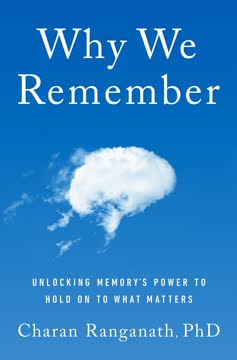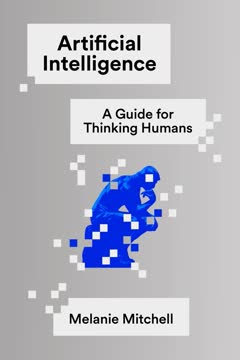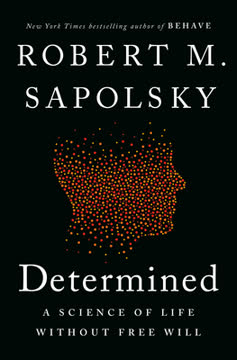نکات کلیدی
1. مغز شما منحصر به فرد است، شکل گرفته توسط ژنتیک و تجربه
"مغز شما شما را اینگونه میسازد."
تعامل طبیعت و تربیت. ویژگیهای منحصر به فرد مغز شما نتیجهی ترکیبی از پیشزمینههای ژنتیکی و تجربیات زندگی است. این تعامل افکار، احساسات و رفتارهای شما را شکل میدهد و شما را به طور خاصی متمایز میکند. مغز انسان با 86 میلیارد نورون، بسیار پیچیده و قابل تطبیق است.
تفاوتهای فردی اهمیت دارند. در حالی که همهی مغزهای انسانی ویژگیهای مشترکی دارند، تفاوتهای بین افراد میتواند قابل توجه باشد. این تفاوتها به شکلهای مختلفی ظاهر میشوند:
- اندازه و ساختار مغز
- سطح انتقالدهندههای عصبی
- الگوهای اتصال عصبی
- سرعت پردازش اطلاعات
- نقاط قوت و ضعف شناختی
درک این تفاوتهای فردی برای قدردانی از تنوع انسانی و توسعهی رویکردهای شخصیسازی شده در آموزش، سلامت روان و توسعهی فردی بسیار مهم است.
2. دو نیمکرهی مغز شما به طور متفاوت اما همکارانه کار میکنند
"اگرچه ممکن است باور کردنش سخت باشد، مغز شما به این شکل کار میکند: در نسخهی خود از بازی تلفن، نجوا بین نورونها با آزادسازی انتقالدهندههای عصبی انجام میشود."
تخصص نیمکرهای. نیمکرههای چپ و راست مغز سبکها و نقاط قوت محاسباتی متفاوتی دارند:
- نیمکرهی چپ: بیشتر بر جزئیات، پردازش زبان و استدلال منطقی متمرکز است
- نیمکرهی راست: بهتر در تفکر کلی، آگاهی فضایی و پردازش احساسی
همکاری کلیدی است. با وجود این تفاوتها، دو نیمکره با هم کار میکنند تا تجربهی یکپارچهای از جهان ایجاد کنند. جسم پینهای، یک دسته از فیبرهای عصبی که نیمکرهها را به هم متصل میکند، امکان تبادل سریع اطلاعات و یکپارچگی را فراهم میکند.
درجهی جانبیسازی (چگونگی تقسیم وظایف بین نیمکرهها) بین افراد متفاوت است و میتواند بر نقاط قوت و ضعف شناختی تأثیر بگذارد. درک تعادل نیمکرهای خود میتواند به شما کمک کند تا از تمایلات طبیعی مغز خود بهرهبرداری کنید و نقاط ضعف احتمالی را جبران کنید.
3. تعادل شیمیایی مغز شما شخصیت و رفتار شما را تحت تأثیر قرار میدهد
"در پایان روز، اگر میخواهید توضیح دهید که چرا افراد در آزمونهای هوش عملکرد متفاوتی دارند، دانستن اندازهی مغز آنها تقریباً 11 درصد از راه را به شما نشان میدهد."
کوکتل انتقالدهندههای عصبی. ترکیب منحصر به فرد انتقالدهندههای عصبی مغز شما، از جمله دوپامین، سروتونین و اکسیتوسین، نقش مهمی در شکلگیری شخصیت و رفتار شما ایفا میکند. این تعادل شیمیایی تأثیر میگذارد بر:
- تنظیم حالت و احساسات
- انگیزه و رفتار جستجوی پاداش
- پیوند اجتماعی و همدلی
- پاسخهای اضطراب و استرس
سیستم پویا. تعادل شیمیایی مغز شما ثابت نیست؛ میتواند تحت تأثیر قرار گیرد توسط:
- ژنتیک
- رژیم غذایی و ورزش
- الگوهای خواب
- سطح استرس
- تعاملات اجتماعی
- عوامل محیطی
درک تمایلات شیمیایی مغز شما میتواند به شما کمک کند تا تصمیمات آگاهانهای دربارهی انتخابهای سبک زندگی و مداخلات احتمالی برای بهینهسازی سلامت روانی و عملکرد خود بگیرید.
4. همگامسازی عصبی بر چگونگی پردازش اطلاعات شما تأثیر میگذارد
"برای درک بهتر رابطه بین تمرکز و کنترل ذهن، باید به جزئیات بیشتری از این ویژگی طراحی بپردازیم."
ریتمهای مغزی اهمیت دارند. همگامسازی فعالیت عصبی در فرکانسهای مختلف بر چگونگی پردازش اطلاعات توسط مغز شما تأثیر میگذارد. نکات کلیدی:
- امواج آلفا (8-12 هرتز): مرتبط با هوشیاری آرام و خلاقیت
- امواج بتا (13-30 هرتز): مرتبط با توجه متمرکز و حل مسئله
- امواج تتا (4-7 هرتز): مهم برای تثبیت حافظه و یادگیری
- امواج گاما (30-100 هرتز): درگیر در عملکردهای شناختی بالاتر
تفاوتهای فردی در همگامسازی. افراد در فرکانسهای عصبی غالب و توانایی تغییر بین حالتهای مختلف مغزی متفاوت هستند. این تفاوتها میتوانند تأثیر بگذارند بر:
- مدت زمان توجه و تمرکز
- ظرفیت یادگیری و حافظه
- انعطافپذیری شناختی
- تواناییهای تفکر خلاق
درک تمایلات ریتمیک مغز شما میتواند به شما کمک کند تا محیط و فعالیتهای خود را برای بهبود عملکرد شناختی و سلامت بهینهسازی کنید.
5. مغز شما به محیط شما تطبیق مییابد و واقعیت شخصی شما را ایجاد میکند
"شما نه بازیگر و نه ناظر منفعل واقعیت خود هستید. شما خالق آن هستید."
نوروپلاستیسیته در عمل. مغز شما به طور مداوم بر اساس تجربیات شما بازسازی میشود، فرآیندی که به عنوان نوروپلاستیسیته شناخته میشود. این تطبیق ادراک شما از واقعیت را شکل میدهد و افکار، احساسات و رفتارهای شما را تحت تأثیر قرار میدهد.
ساخت واقعیت شخصی. عوامل کلیدی در چگونگی ایجاد تجربهی ذهنی شما توسط مغز:
- توجه انتخابی: مغز شما اطلاعات ورودی را بر اساس ارتباط و تجربیات گذشته فیلتر میکند
- تشخیص الگو: مغز شما به دنبال یافتن الگوهای آشنا در موقعیتهای جدید است
- یکپارچگی حافظه: تجربیات جدید در پرتو خاطرات گذشته تفسیر میشوند
- رنگآمیزی احساسی: حالت احساسی شما بر چگونگی ادراک و به خاطر سپردن رویدادها تأثیر میگذارد
درک این که واقعیت شما ساخت مغز شماست میتواند به شما کمک کند:
- بیشتر به دیدگاههای مختلف باز باشید
- به طور انتقادی به تعصبات و فرضیات خود نگاه کنید
- تجربیات خود را به طور فعال شکل دهید تا تغییرات مثبت مغزی را ترویج دهید
6. کنجکاوی و کاوش دانش و تصمیمگیری مغز شما را شکل میدهند
"کنجکاوی اغلب به عنوان یک ویژگی مطلوب به تصویر کشیده میشود. با این حال، کنجکاوی ممکن است هزینهای داشته باشد که گاهی افراد را در موقعیتهای مضر قرار میدهد."
کنجکاوی به عنوان نیروی محرک. کنجکاوی انگیزهی کاوش و یادگیری را فراهم میکند و منجر به گسترش پایگاه دانش مغز شما میشود. مزایای کنجکاوی شامل:
- بهبود حافظه برای اطلاعات جدید
- افزایش آزادسازی دوپامین، ترویج احساسات مثبت و انگیزه
- بهبود تواناییهای حل مسئله
- تطبیقپذیری بیشتر به موقعیتهای جدید
تعادل بین کنجکاوی و احتیاط. در حالی که کنجکاوی به طور کلی مفید است، ضروری است که آن را با:
- ارزیابی ریسک: ارزیابی خطرات احتمالی کاوش
- کنترل تکانه: مدیریت تمایل به جستجوی رضایت فوری
- تخصیص منابع: تصمیمگیری در مورد جایی که باید توجه و انرژی خود را متمرکز کنید
پرورش کنجکاوی سالم در حالی که احتیاط مناسب را حفظ میکنید میتواند به تجربهی زندگی غنیتر و تصمیمگیری بهتر منجر شود.
7. درک دیگران نیازمند مدلسازی ذهنی انعطافپذیر و ارتباط است
"افراد از نزدیک سختتر به نفرت میرسند. نزدیک شوید."
نظریهی ذهن. توانایی درک و پیشبینی حالات ذهنی دیگران، که به عنوان نظریهی ذهن شناخته میشود، برای تعامل اجتماعی و همدلی حیاتی است. این مهارت شامل:
- گرفتن دیدگاه: تصور خود در موقعیت دیگری
- تشخیص احساسات: تفسیر حالات چهره و زبان بدن
- درک زمینهای: در نظر گرفتن عوامل موقعیتی که بر رفتار تأثیر میگذارند
مدلسازی ذهنی انعطافپذیر. تعامل اجتماعی مؤثر نیازمند تطبیق مدلهای ذهنی شما از دیگران بر اساس اطلاعات و تجربیات جدید است. این انعطافپذیری امکان میدهد:
- ارتباط و حل تعارض بهتر
- افزایش همدلی و دلسوزی
- بهبود کار تیمی و همکاری
- کاهش تعصب و کلیشهسازی
توسعهی تواناییهای مدلسازی ذهنی شما میتواند به روابط غنیتر و معنادارتر و عملکرد اجتماعی بهبود یافته در زمینههای مختلف منجر شود.
آخرین بهروزرسانی::
FAQ
1. What is The Neuroscience of You by Chantel Prat about?
- Exploring brain individuality: The book explains how every brain is uniquely shaped by biology and life experiences, influencing how we think, feel, and behave.
- Beyond one-size-fits-all neuroscience: Prat delves into individual differences in brain structure, chemistry, and function, challenging common myths about the brain.
- Personal and scientific blend: The author combines neuroscience research with personal stories to make complex concepts relatable and practical for everyday life.
2. Why should I read The Neuroscience of You by Chantel Prat?
- Gain self-understanding: The book helps readers understand their own brain’s unique design, strengths, and challenges, fostering greater self-awareness.
- Practical insights for life: It offers assessments and explanations that empower readers to apply neuroscience to personal growth, relationships, and decision-making.
- Empathy and connection: By highlighting how brains differ, Prat provides tools for better communication and empathy in social and professional settings.
3. What are the key takeaways from The Neuroscience of You by Chantel Prat?
- Every brain is different: Individual differences in brain structure, chemistry, and rhythms shape our thoughts, behaviors, and personalities.
- Nature and nurture interplay: Genetics and life experiences both play crucial roles in shaping the brain, making it a dynamic, ever-changing organ.
- Understanding leads to empowerment: Awareness of your brain’s unique wiring can help you leverage your strengths and navigate challenges more effectively.
4. What are the best quotes from The Neuroscience of You by Chantel Prat and what do they mean?
- “Your brain is a moving target.” This highlights the brain’s constant adaptation to new experiences and environments.
- “There is no such thing as a ‘normal’ brain.” Prat emphasizes that brain diversity is the norm, not the exception.
- “The horse and rider must learn to work together.” This metaphor illustrates the partnership between intuitive and controlled brain systems in guiding behavior.
5. How does The Neuroscience of You by Chantel Prat explain brain lateralization and handedness?
- Lopsided brains explained: Human brains are structurally asymmetrical, with hemispheres specializing in different types of processing.
- Handedness as a marker: Hand preference reflects underlying brain lateralization, with most people being right-handed and left-hemisphere dominant for language.
- Costs and benefits: Highly lateralized brains may excel in specific tasks but are more vulnerable to injury, while balanced brains are more resilient and integrate information more globally.
6. What is the “horse and rider” metaphor in The Neuroscience of You by Chantel Prat?
- Horse as intuition: The horse represents the brain’s intuitive, automatic, and reward-driven systems, learning from experience without conscious awareness.
- Rider as conscious control: The rider symbolizes the prefrontal cortex, using language and explicit goals to guide behavior, but can tire quickly.
- Interaction and learning: With practice, the rider can train the horse, making controlled behaviors more automatic over time.
7. How does The Neuroscience of You by Chantel Prat describe the role of neurotransmitters in personality and behavior?
- Dopamine and extraversion: Dopamine drives reward-seeking and motivation, with extraverts showing stronger responses to unexpected rewards.
- Serotonin and emotional balance: Serotonin helps regulate mood and inhibits excessive dopamine-driven wanting, influencing anxiety and stability.
- Stress and neurochemistry: Stress hormones interact with neurotransmitter systems, affecting creativity, motivation, and mental health.
8. What does The Neuroscience of You by Chantel Prat say about neural rhythms and brain synchronization?
- Brain as a rhythm generator: Neurons communicate in rhythmic cycles, coordinating information flow and enabling flexible task management.
- Alpha frequency and cognition: Preferred alpha rhythms correlate with working memory and processing speed, with faster rhythms supporting multitasking and slower ones linked to creativity.
- Trade-offs in synchronization: High-frequency rhythms aid real-time processing but limit integration, while low-frequency rhythms support integration but can cause attentional lapses.
9. How does The Neuroscience of You by Chantel Prat explain attention, focus, and the basal ganglia’s role?
- Hierarchy of focus: Attention ranges from automatic noticing to controlled, goal-directed focus and self-monitoring.
- Basal ganglia as conductor: These brain nuclei route relevant signals based on context and goals, collaborating with the prefrontal cortex for decision-making.
- Learning through dopamine: The basal ganglia use dopamine feedback to prioritize signals, shaping flexible, goal-directed behavior.
10. How does The Neuroscience of You by Chantel Prat describe reinforcement learning and the “carrot and stick” method?
- Four-step process: The brain builds environmental models, considers actions, selects those with the highest expected reward, and updates based on outcomes.
- Dopamine’s dual role: Dopamine surges signal positive outcomes (“carrot”), while dips signal negative outcomes (“stick”), shaping learning.
- Individual differences: People vary in their sensitivity to reward versus punishment, influencing their learning and decision-making styles.
11. What does The Neuroscience of You by Chantel Prat reveal about memory, meaning maps, and knowledge representation?
- Declarative and procedural memory: The rider uses declarative memory for facts and experiences, while the horse relies on procedural, intuitive memory.
- Meaning maps in the brain: Semantic knowledge is distributed in patterns of brain activation, organized by themes like function or use.
- Individual differences: Personal experience and attentional focus shape how concepts are represented and retrieved in the brain.
12. How does The Neuroscience of You by Chantel Prat connect curiosity, social connection, and understanding others’ minds?
- Curiosity as a motivator: Curiosity activates dopamine circuits, enhancing learning and memory by signaling anticipated knowledge rewards.
- Oxytocin and bonding: Oxytocin boosts social pleasure and reduces stress, motivating connection and influencing bonding behaviors.
- Mind modeling and teamwork: Skills like reading emotions and theory of mind improve empathy, communication, and collective intelligence in groups.
نقد و بررسی
کتاب علوم اعصاب شما به بررسی چگونگی تأثیر تفاوتهای فردی در مغز بر افکار، رفتارها و شخصیتها میپردازد. خوانندگان از سبک نوشتاری قابل فهم، حکایات جذاب و آزمونهای عملی آن تمجید کردهاند. بسیاری آن را آموزنده و بینشافزا یافتند و از تأکید نویسنده بر یکتایی مغز و تفاوتهای فردی قدردانی کردند. برخی از پاورقیهای بیش از حد و انحرافات انتقاد کردند. به طور کلی، این کتاب به دلیل دیدگاه تازهاش در مورد علوم اعصاب، که بر تفاوتهای فردی مغز به جای میانگینها تمرکز دارد، و ارائه درک عمیقتری از خود و دیگران، مورد استقبال قرار گرفت.
Similar Books












